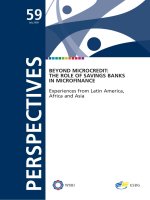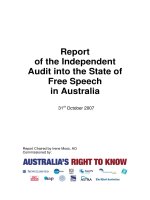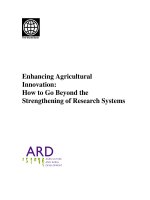MANAGING THE RISKS OF PAYMENT SYSTEMS CHAPTER 7 potx
Bạn đang xem bản rút gọn của tài liệu. Xem và tải ngay bản đầy đủ của tài liệu tại đây (89.58 KB, 16 trang )
185
7
Commerce and Payments
in Cyberspace
Electronics and the Internet have created great changes
in how commerce is conducted and payments are made in
the United States. This chapter considers how communi-
cations can legally bind the parties despite the absence of
a signed, written agreement. It discusses “digital signa-
tures”; “electronic checks,” bill payment and present-
ment; procurement; “smart cards,” including purchasing
cards and stored value cards; home banking; money laun-
dering; and the privacy rights of bank customers.
REVOLUTIONS IN PAYMENT SYSTEMS
The last half of the twentieth century and the beginning of the
twenty-first century witnessed revolutionary developments in pay-
ment systems in the United States.
Checks today are processed with magnetic ink character
recognition (MICR) line coding near the bottom of the check, a
technology that was developed in the 1950s. The 1970s saw the
advent of the fax machine, the automated teller machine (ATM),
the point-of-sale (POS) machine, and the processing of checks
through automated clearing house (ACH) associations. In the
1960s and 1970s, the Federal Reserve Wire Network (Fedwire),
the New York Clearing House Association’s Clearing House
Interbank Payments System (CHIPS), and the Society for
Worldwide Interbank Funds Transfers (SWIFT) were created and
became important means of sending large-dollar wire transfers
on an automated basis, both domestically and internationally.
The 1980s saw the development of the personal computer (PC).
The 1990s saw the mushrooming of applications for the com-
puter and the popularization of e-mail, browsing on the World
Wide Web, electronic commerce transacted on the Internet, and
the proliferation of new electronic payment products. Payment
system law has sometimes struggled to keep pace with these
developments but, on the whole, has managed rather well.
PAPERLESS TRANSACTIONS AND COMMUNICATIONS
Consider three types of transactions: In the first transaction, a
consumer wants to buy this book. The consumer goes on-line to
the Internet, points the browser to an e-commerce bookseller,
and orders the book. On the web site, the consumer is asked to
provide a credit card number. The consumer gives the number
and clicks on the appropriate box or icon to confirm the order.
The web site uses an attribution procedure to verify the confi-
dentiality and integrity of the consumer’s message. A chain of
messages from the web site to the bank that issued the credit card,
and to the merchant’s bank, results in the payment to the mer-
chant. The charge to the consumer appears on the consumer’s
next monthly statement from the credit card issuer. The transac-
tion is traditionally finalized, from the consumer’s point of view,
when the consumer’s check to the credit card issuer is paid by the
consumer’s bank. In today’s environment, the consumer may
alternatively pay the credit card issuer via the Internet, by visiting
the issuer’s web site, or by utilizing the services of a consolidator
that provides electronic bill presentment and payment services.
186
Commerce and Payments in Cyberspace
In the second transaction, an investment company wishes to
purchase stock for $50,000 through a stock brokerage firm. The
company sends an order to the brokerage firm by e-mail, using
an encryption method that the parties have agreed to use for
security purposes. The brokerage firm decrypts the message,
acknowledges receipt of the order by encrypted e-mail to the
investment company, and purchases the stock for the account of
the company. There is no signed customer agreement between
the company and the brokerage firm.
In the third transaction, a large automobile manufacturing
company purchases parts and supplies from a supply company. A
computer at the manufacturer’s plant monitors the level of parts
and supplies maintained by the manufacturer. When the supply
on hand of a part required in the manufacture of a carburetor
drops below the desired level, the computer automatically orders
an additional supply of the part from the supply company by e-
mail, using an encryption method. A computer at the supply
company decrypts the message, acknowledges receipt of the mes-
sage by e-mail to the manufacturer, instructs the shipping depart-
ment to send the parts to the manufacturer, and bills the
manufacturer for the parts. The computer at the manufacturer’s
office sends a wire transfer to the supply company’s bank, refer-
encing the invoice number and providing other information
relating to the sales transaction. In this transaction, the parts are
ordered and paid for essentially on a wholly automated basis.
The transactions described here are examples of electronic
commerce on the Internet. Although any of the documents gen-
erated in the parties’ computers can be printed out, the docu-
mentation consists of electronic records, not paper records, and
the process of contracting between the parties is a wholly elec-
tronic and paperless process.
Statute of Frauds
All 50 states have enacted laws that generally require contractual
undertakings to be in writing and signed by the parties obligated
187
Paperless Transactions and Communications
to perform under the contract. These laws are known as the
“statute of frauds.”
The term statute of frauds is probably inapt. The statutes do
not directly address liability for fraud; rather, their purpose is to
eliminate litigation over oral obligations. If the party claiming
the right to payment, for example, is unable to produce a written
document in which the other party has agreed to make the pay-
ment, then the claimant cannot enforce the alleged payment
obligation in court. A great deal of difficult litigation that might
otherwise clog the courts is thereby eliminated.
The statute of frauds typically applies to obligations that
exceed a minimum amount. For example, suppose that the statute
of frauds applicable to the transactions in the examples given here
provides that any obligation in excess of $500 must be stated in a
written document. Suppose also that the buyer of this book repu-
diates its obligation to buy the book on the grounds that there was
no agreement in writing signed by the buyer to buy the book. The
statute of frauds will not support the buyer’s position, because the
purchase price of the book is less than $500 and the statute of
frauds does not apply to obligations of less than $500.
If the company that ordered stock through a brokerage firm
repudiates its obligation to purchase the stock, the statute of
frauds will support the company’s position, because the purchase
price for the stock is $50,000, that is, in excess of the $500 statute
of frauds amount. The brokerage firm cannot enforce the
buyer’s obligation, because the company did not execute an
agreement in writing to buy the stock.
Uniform Electronic Transactions Act and Electronic
Signatures in Global and National Commerce Act
To facilitate electronic commerce, many states have adopted a
law known as the Uniform Electronic Transactions Act (UETA)
and Congress has enacted the Electronic Signatures in Global
and National Commerce Act (E-SIGN). E-SIGN was enacted by
188
Commerce and Payments in Cyberspace
Congress generally subsequent to the adoption of the UETA by
the states that have adopted it. Generally, E-SIGN, as the federal
law, preempts the UETA, but a provision of E-SIGN states that
the UETA, rather than E-SIGN, will prevail in a state that has
adopted the UETA in substantially the same form as the UETA
proposed by the uniform law commissioners who drafted it.
The UETA and E-SIGN apply to “records,” which consist of infor-
mation inscribed on a tangible medium or stored in an electronic or
other medium and are retrievable in perceivable form. Thus, a mes-
sage stored in a computer’s hard drive that is “perceivable” by view-
ing on a monitor, or by printing the message, is a record.
The most significant of the provisions of E-SIGN and the
UETA states simply that contractual obligations need not be in
writing but may instead be documented as an electronic record.
Electronic records are placed on an equal footing with paper
records. This provision applies despite the existence of a statute of
frauds that would otherwise deny the legal effect or validity of the
paperless electronic record.
Traditional contract law requires that a party cannot be forced to
perform a contractual obligation unless that party has signed the con-
tract. E-SIGN and the UETA place an “electronic signature” on an
equal footing with a handwritten signature. A person’s name typed
on a computer keyboard might constitute an identifying symbol,
adopted by the person typing the name, as part of the electronic
record in which the name is typed. If the sender of an electronic
record encrypts the record so that the receiving party must decrypt
it in order to understand it, the sender has “signed” the record by
encrypting it. The typed name constitutes an “electronic signature”
and is binding as a signature under the UETA and E-SIGN.
PUBLIC KEY INFRASTRUCTURE
Digital Signatures
An “electronic signature” and a “digital signature” are not
the same; these terms have quite different meanings as they are
189
Public Key Infrastructure
generally used today. An electronic signature, under E-SIGN and
the UETA, is, broadly, a symbol or process used for purposes of
identification that is adopted as part of a record. Such a process
would include the encryption of a record. The term digital signa-
ture, however, is commonly used to refer more narrowly to the
encryption of a record as part of a cryptographic process that
includes what are known as “private keys” and “public keys.” Thus,
the term electronic signature generally includes a digital signature,
as utilized in the public key infrastructure discussed below.
Private Keys
The two parties in a private key transaction share the same code to
encrypt and decrypt a message. Because the same key is used for
encryption and decryption, this cryptography is called “symmet-
ric” cryptography. The “Captain Midnight” code is an example of
a symmetric private key. In that code, “A” equals “Z,” “B” equals
“Y,” and so on. “Captain Midnight” is “Xzkgzrm Nrwmrtsg.”
Captain Midnight refers to the radio show hero’s secret code.
Private key cryptography works very well in closed systems
with a limited number of participants. The private key concept,
however, is subject to question in an open system, like the
Internet, because no distribution method can securely deliver all
the keys to everyone needing a digital signature on the Internet.
In particular, persons who have never communicated with each
other cannot both have knowledge of the key.
Public Keys
The problem of private key distribution is solved in the “public
key infrastructure” (PKI) with two keys. The owner has both a
private key and a public key. The private key, of course, is main-
tained with great secrecy, but the public key of the owner is
widely distributed, often even available through the Internet.
The public and private keys are related mathematically, but it is
not computationally feasible to derive one key on the basis of
knowledge of the other.
190
Commerce and Payments in Cyberspace
In the public key infrastructure, the sender of an electronic
message creates a “message digest” and encrypts the digest, uti-
lizing the private key of the sender. The encrypted digest is the
“digital signature.” The recipient of the message then uses the
public key of the sender to decrypt the message.
Certifying Authorities
One problem remains in the public key infrastructure: How can
the receiver have confidence that the key obtained publicly is in
actual fact the authentic key of the sender?
The public key infrastructure seeks to solve this problem by
using a trusted third party as a certifying authority (CA), which
may be a bank or a bank consortium. The CA issues certificates
to its subscribers. A certificate issued by the CA identifies the CA,
identifies the subscriber, contains the subscriber’s public key,
states the time period in which the public key is operational, and
is digitally signed by the CA.
The subscriber sends the certificate to persons with whom
the subscriber wishes to do business, and those persons rely on
the certificate as proof of the subscriber’s identity. Because the
certificate is digitally signed (see the earlier description of digital
signatures) by the CA, the recipient of the certificate can use the
public key of the CA to verify the digital signature of the CA on
the certificate.
ELECTRONIC CHECKS
The term electronic check (or e-check) refers rather vaguely to
paperless payment systems. More specifically, the term may be
applied to the conversion of a consumer’s check into an ACH
debit transfer, as described in the discussion of ACH transactions
in Chapter 6. It may also be applied to telephone-initiated or
Internet-initiated ACH transactions.
Check conversion at the point of purchase is a good illustra-
tion of what may be called an “electronic check” transaction. For
191
Electronic Checks
example, the consumer at a department store hands a check to
the clerk at the cash register. The merchant inserts the check
into a check reader that records the routing number, account
number, and check number from the MICR line on the check. A
sign may be posted next to the cash register indicating that
checks presented at the register may be used to create “elec-
tronic checks” to be sent for collection by debits to the con-
sumer’s account. The cashier voids the check and gives the
consumer the voided check and a receipt. The monthly bank
statement received by the consumer shows the merchant’s name
as well as the check number and the date of the debit.
The great advantage of check conversion for merchants is in
the cost savings—in particular, savings in front-end and back-
office time and labor in collecting and reconciling checks for
deposit into the merchant’s depository bank, as well as in check
deposit and encoding fees. In addition, the merchant receives
earlier notification of returned checks, approximately 3 to 6 days
in the case of a returned ACH debit entry, as opposed to about 8
to 12 days for a paper check. The earlier notice improves collec-
tion efforts and fraud detection.
Other examples of ACH transactions that can be described as
involving electronic checks are “accounts receivable” entries,
“returned check” entries, “telephone-initiated” entries, and
“Internet-initiated” entries.
An accounts receivable entry and a returned check entry also
start with a consumer’s check. In an accounts receivable entry,
the consumer mails the check to a merchant or to the mer-
chant’s dropbox. Instead of depositing the check, the merchant
voids it and uses the information on the check to initiate a debit
entry to the consumer’s account. In a returned check entry, the
merchant uses the information on a check that has been
returned for insufficient funds to initiate the debit entry to the
consumer’s account.
In a telephone-initiated entry, the consumer authorizes a mer-
chant over the telephone to initiate the debit transfer. The ACH
rules allow such entries only if the consumer has purchased goods
192
Commerce and Payments in Cyberspace
TEAMFLY
Team-Fly
®
from the merchant within the past two years, there is a written
agreement between the consumer and the merchant, or it is the
consumer (not the merchant) who initiated the telephone call. In
an Internet-initiated entry, the consumer authorizes a merchant
to initiate a debit transfer from the consumer’s account while the
consumer is shopping on the merchant’s web site.
ELECTRONIC BILL PRESENTMENT AND PAYMENT
In the electronic bill presentment and payment (EBPP) envi-
ronment, three business models are used:
1. Biller-Direct Model. The bill payor goes on-line to the biller’s
web site to retrieve and pay on-line the biller’s bills.
2. Customer Consolidation Model. Each biller goes on-line to a
specified web site and posts its bills, including the pay-
ment information. Then a customer goes to the site to
review and pay the bills posted by the various billers.
3. Service Provider Consolidator Model. A consolidator consoli-
dates the bills of multiple billers for access by the payers at
the service provider’s web site. In the service provider con-
solidator model, the service provider consolidator typically
displays a summary of each bill (the “thin” model in EBPP
parlance). If the payer wants complete detailed billing
information (the “thick” model), a link to the biller’s web
site normally offers the means to satisfy the payor’s needs.
B2B versus B2C
In EBPP, a distinction is made between systems for consumer
payments and those for business payments. Business-to-business
systems are known as B2B (“be-to-be”) and business-to-consumer
systems as B2C (“be-to-see”).
EBPP Advantages for Business Billers. In the more sophisticated
EBPP systems, when a bill has been paid, the system allows the
biller to credit the payment to the payor’s account receivable.
193
Electronic Bill Presentment and Payment
Another advantage to the billers that use an EBPP system is the
elimination of the costly paperwork of printing, stuffing, and
mailing bills. Also eliminated is the processing of customers’
checks, which includes a reduction of bank charges (e.g., for
check deposit, check encoding, and lockbox processing).
ELECTRONIC PROCUREMENT
Many organizations address procurement, purchasing, and pay-
ments as three separate paper-based processes. For any one item,
a company researches products and suppliers, submits a pur-
chase order, and buys the product. The process can take days or
weeks, with associated personnel expense. Using the Internet
can reduce the purchasing and procurement cycle to a few days
or hours and reduce transaction costs as well.
Smart Cards
A smart card is a card about the size of a credit card that contains
an integrated microcomputer chip. The card has the capacity to
store different types of information, including account numbers
and credit lines and other data that can allow it to be used as
both a credit card and a debit card, that is a card that can create
debits to the bank account of a consumer, the employer of the
card holder, or a trading partner. In addition, the smart card may
hold personal information, such as health data, and may be used
as a security token for the prevention of fraud. Smart cards may
be used as purchasing cards or as stored value cards, but not all
such cards have the capacity to debit a bank account.
Purchasing Cards
The most common form of purchasing card is used for the record-
ing and control of the travel and entertainment (T&E) expenses
of a company’s employees. These cards greatly simplify the process
of filling out travel and expense forms and help to reconcile
194
Commerce and Payments in Cyberspace
expense reports, allocate expenses by category, create travel and
expense reports, and provide data to the card users and company
managers via the Internet or through corporate intranets. The
T&E cards can greatly reduce the cost of processing expense
reports and speed up reimbursement to the employee.
A more ambitious form of purchasing card combines T&E
reporting with general procurement. For example, a company
may use a purchasing card that automatically reconciles and inte-
grates a charge to the card for supplies and inventory into the gen-
eral ledger of the company. That use can result in considerable
savings in the costs of buying, paying, and reconciliation.
A significant advantage of the use of a purchase card as part
of an electronic procurement system is the ability of the card to
authenticate the originator. In effect, the use of the card auto-
matically transmits to the recipient of any communication the
“digital signature” of the sender.
Stored Value Cards
Stored value cards may be either smart cards or cards that use
magnetic stripe technology. Stored value cards have been in use
in Europe for a number of years and are widely accepted there.
They have not been as widely accepted in the United States.
A stored value card typically allows a consumer to place
“value” on the card and to download that value at the place where
payment is to be made. For example, value may be placed on a
card at an ATM or at the counter of the bank. The consumer may
then present the card at the cash register of a merchant, and the
cashier inserts the card into a terminal that will download the
value from the card for credit to the merchant’s account.
Closed System Stored Value Card. A stored value card that is used
in a closed system is limited in how it may be used. Prepaid tele-
phone cards, for example, that are used to pay for telephone
calls operate in a closed system, because they can be used only
for that purpose and only through the telephone company or
195
Electronic Procurement
companies that are a part of the system. For example, the card
issued by the New York City Metropolitan Transit Authority
(MTA) may be used only to pay the MTA for bus and subway
transportation in that city.
A card that is used in a closed system may, however, be used
within that system for many purposes. At the Marine Corps train-
ing camp at Camp Lejeune, North Carolina, for example, stored
value cards issued to the Marines are used to pay for haircuts, soft
drinks, and bowling games and to check out assault weapons
from the armory. A card issued by a university is typically used in
that university’s closed system, but it may be used within the sys-
tem for a variety of purposes, such as to pay for books, food,
transportation, lodging, photocopying, and other services.
A relatively recent type of stored value card is the payroll pay-
ment card. A payment card can be issued to an employee in lieu
of a payroll check. Especially in a case in which direct deposit by
ACH transfer to the employee’s account is not feasible—the sit-
uation for an employee who has no bank account—a payment
card may be a useful alternative.
A payment card can be issued with the value already stored
on the card or issued in a form that will allow the employee to
load value onto the card at the counter of a bank or at an ATM
machine. Some payment cards can be used, as conventional
stored value cards are used, to download value at the terminal of
a merchant in order to pay for purchased consumer goods.
Open System Stored Value Card. An example of an open system is
the joint Visa and MasterCard pilot program conducted in late
1997 on the Upper West Side of New York City. Free cards were
offered and some terminals were given free to merchants,
but the results were disappointing and the program terminated
in 1998.
Home Banking. A bank customer may use a personal computer
to pay merchants for personal, family, or household expenses.
Home banking allows the customer to view account balances,
196
Commerce and Payments in Cyberspace
review recent transactions, transfer funds between accounts at the
bank, order documents, establish automatic transfers (such as the
direct deposit of paychecks and the automatic payment of insur-
ance premiums), and communicate with the bank via e-mail.
The one feature that is not yet available to the consumer sit-
ting at the computer is the delivery of cash in the form of
deposits to and withdrawals from the bank. Perhaps at some time
in the future stored value cards can be used to allow the con-
sumer to transfer value from an account at the bank to the card
at home in much the same way in which value is transferred from
an account to a stored value card at an ATM.
MONEY LAUNDERING
Money laundering is a process by which funds obtained illegally
are made to appear to have been obtained legally. Money laun-
dering is typically difficult to detect and may be even more diffi-
cult to detect when the wrongdoer uses electronic funds
transfers.
The principal legislation applicable to money laundering in
the United States is the Bank Secrecy Act. The Act and its regu-
lations make money laundering illegal and require covered insti-
tutions to disclose certain transactions. The Financial Crimes
Enforcement Network (FinCEN) of the Treasury Department has
primary responsibility for enforcing the Act.
The USA Patriot Act, enacted in 2001, adopted new provisions
and amended the Bank Secrecy Act to broaden its anti-money
laundering provisions, make certain records accessible to federal
authorities, and require covered institutions to take special meas-
ures and exercise special diligence with respect to accounts main-
tained for non-U.S. persons.
The institutions are required to file Currency Transaction
Reports (CTRs) with respect to large currency transactions and
Suspicious Activity Reports (SARs) with respect to transactions
that appear to indicate money laundering or other suspicious
conduct. A CTR is required for a transaction of $10,000 or more.
197
Money Laundering
A suspicious transaction must be reported if it involved $5,000 or
more in funds or other assets and the bank or broker dealer has
reason to suspect that the funds were diverted from illegal activi-
ties or the transaction is intended to hide illegal funds sources. A
transaction is also suspicious when it involves the layering of a
series of transactions broken down into amounts of less than
$10,000 to avoid the filing of a CTR or if it has no business or
apparent lawful purpose or is not the sort in which the customer
would normally be expected to engage and the firm knows of no
reasonable explanation for the transaction after examining the
available facts.
Just as FinCEN is the money laundering watchdog in the
United States, the Financial Action Task Force (FATF) is the inter-
national watchdog. The FATF was created by the Group of Seven
Nations for the purpose of developing and promoting programs to
deter money laundering. The FATF publishes an annual report on
money laundering activities and has issued “40 Recommendations”
as part of its mission to deter money laundering.
In addition to banks, there are many nondepository money-
service businesses (MSBs) that provide financial services, such as
money transmitters, check cashers, and foreign currency
exchanges. The MSBs generally receive less attention by regula-
tors than do the banks. A number of states have adopted legisla-
tion that attempts to address the activities of MSBs, but the lack of
effective oversight has made meaningful enforcement difficult.
PRIVACY RIGHTS
An important issue in the detection of money laundering is con-
cern for the privacy rights of the customers of the banks. The
Gramm-Leach-Bliley Act restricts the ability of a bank or other
financial institution to disclose nonpublic, personal information
about a consumer to nonaffiliated third parties. The Act also
requires the institutions to disclose to their customers their pri-
vacy policies and practices as they relate to the sharing of infor-
mation with both affiliates and nonaffiliated third parties.
198
Commerce and Payments in Cyberspace
The Federal Reserve has adopted regulations for the purpose
of implementing the Act. The Federal Reserve regulations gen-
erally require a financial institution to make an initial disclosure,
and then periodically an annual disclosure, to its customers that
describes the institution’s privacy policies. The Act and the regu-
lations thus deal with two kinds of disclosures. First, the financial
institution is prohibited from disclosing private information
about its customers. Second, the Act requires that the institution
disclose to its customers information about its privacy policies.
Unless an exception applies or the customer has “opted out”
of the requirements of the Act, the Act prohibits an institution
from disclosing “nonpublic” information to a nonaffiliated third
party. The Act also prohibits such disclosure if the institution has
not made the disclosures to the customer that the Act requires
the institution to make.
The disclosures required by the Act must inform the cus-
tomer that the institution does not disclose nonpublic personal
information about its current and former customers to affiliates
or nonaffiliated third parties, except as authorized by the Act.
The disclosures must also describe the categories of nonpublic
personal information collected by the institution and the institu-
tion’s policies and practices with respect to protecting the confi-
dentiality and security of nonpublic personal information.
An institution may not claim that a customer has opted out
of the privacy provisions of the Act unless:
• The bank has provided an ”opt out’” notice to the consumer,
• The bank has given the consumer a reasonable opportu-
nity, before it discloses the information, to opt out of the
disclosure, and
• The consumer has not, in fact, opted out.
As noted earlier, the privacy provisions relate to the bank’s dis-
closing “nonpublic” information. There is no restriction on the
disclosure of information that is “public” information. Nonpublic
information includes personally identifiable financial information
199
Privacy Rights
as well as lists or description of consumers that are derived by the
use of personally identifiable financial information.
INTEGRATING RISK MANAGEMENT
Risk management of commerce and payments in cyberspace
should be integrated into a company’s risk management plan
and monitoring of its corporate payment systems. These innova-
tions should not be regarded as more secure because they are
new and technologically impressive.
200
Commerce and Payments in Cyberspace








![managing the risks of it outsourcing [2005]](https://media.store123doc.com/images/document/14/ne/qk/medium_qka1401862854.jpg)
